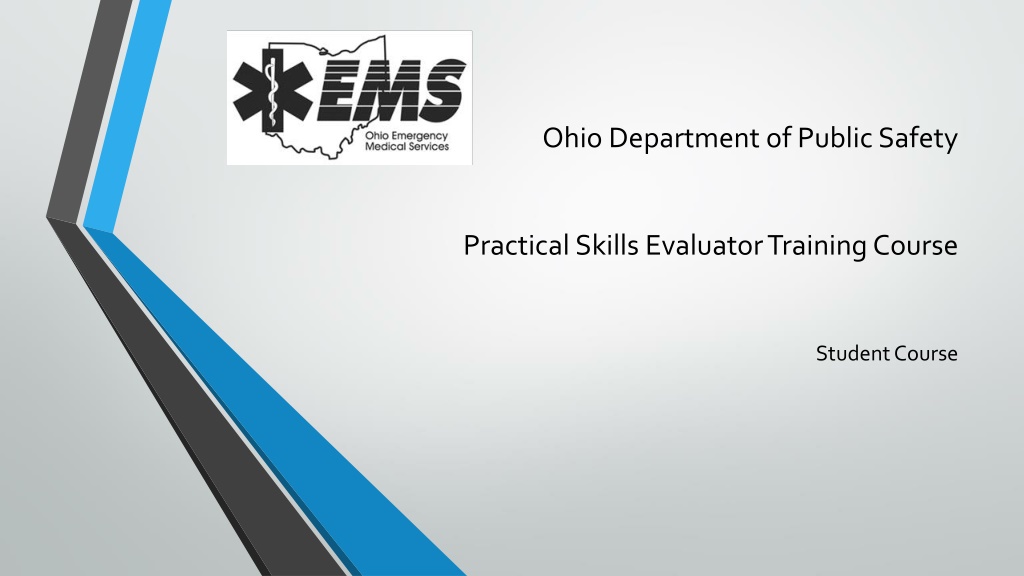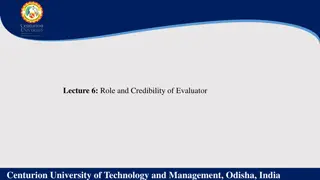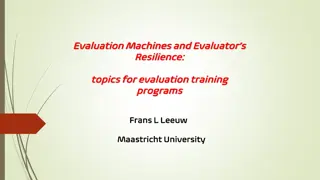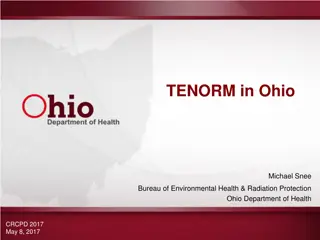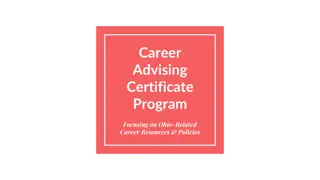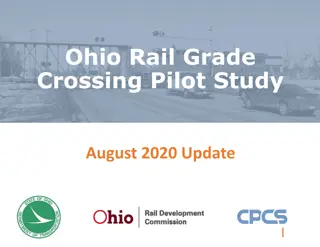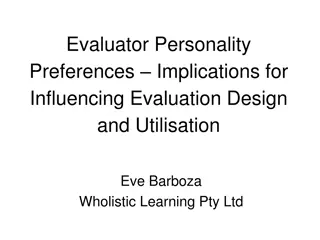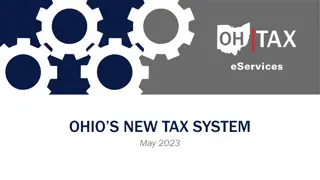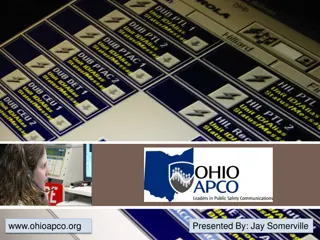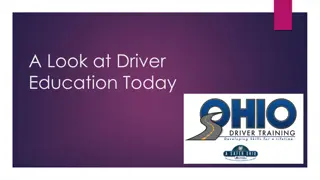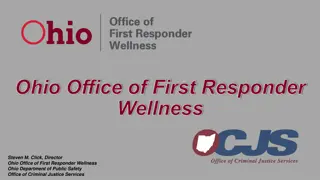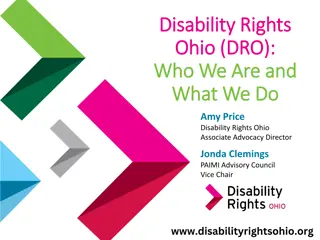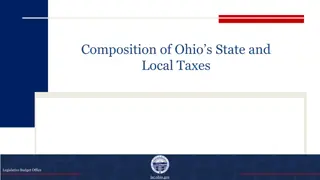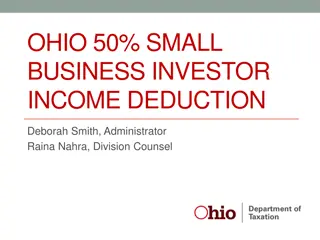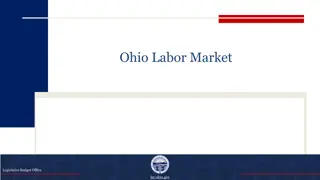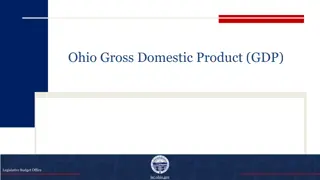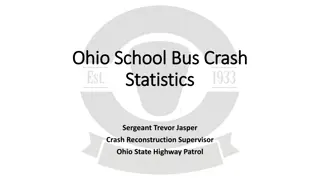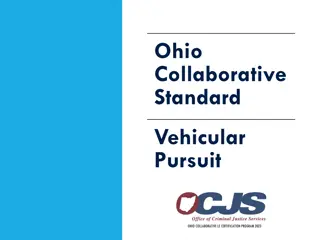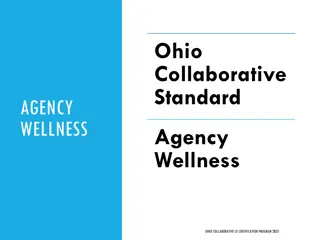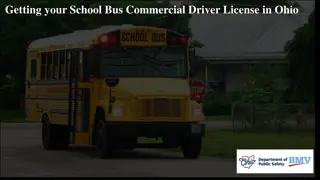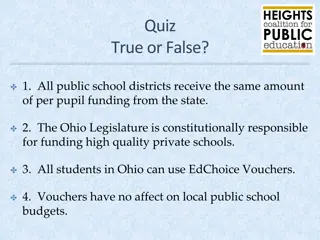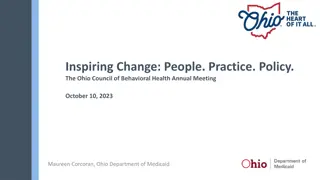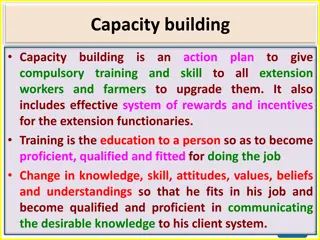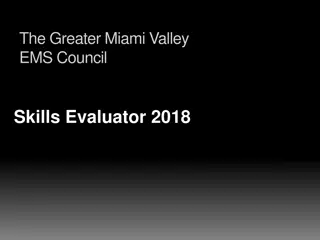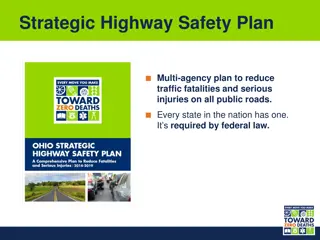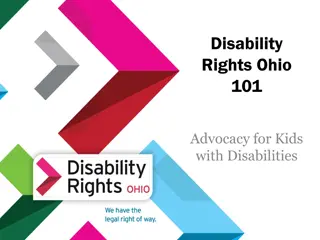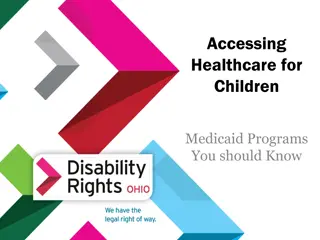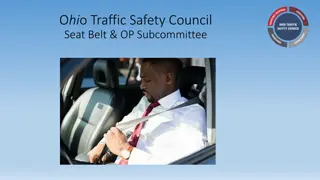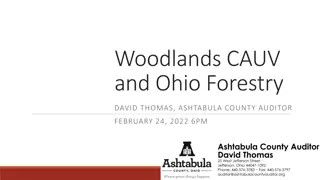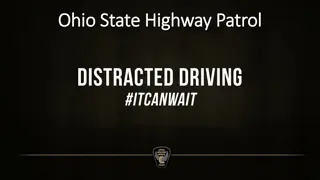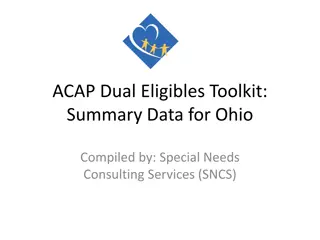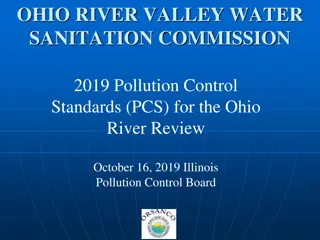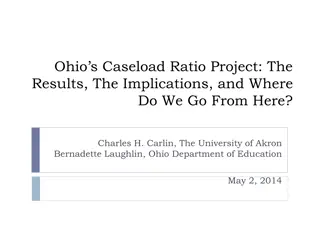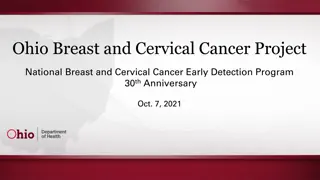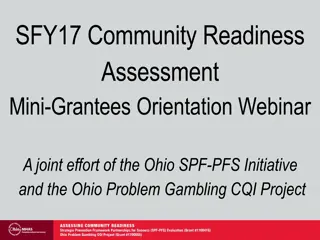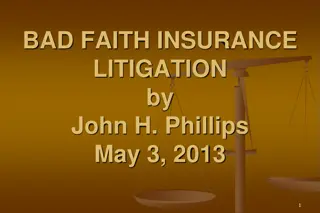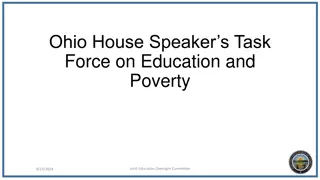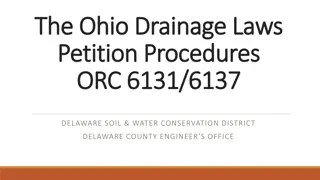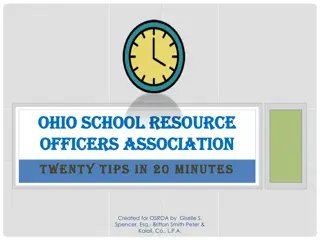Ohio Department of Public Safety Practical Skills Evaluator Training Course
This training course offered by the Ohio Department of Public Safety prepares participants to conduct practical skills evaluations in line with Ohio Administrative Code requirements and National Fire Protection Association standards. Participants learn testing roles, responsibilities, and administration practices. The course targets certified fire instructors and inspectors serving as evaluators and covers basic certification concepts, Pro Board accreditation, legal issues, and more.
Download Presentation

Please find below an Image/Link to download the presentation.
The content on the website is provided AS IS for your information and personal use only. It may not be sold, licensed, or shared on other websites without obtaining consent from the author. Download presentation by click this link. If you encounter any issues during the download, it is possible that the publisher has removed the file from their server.
E N D
Presentation Transcript
Ohio Department of Public Safety Practical Skills Evaluator Training Course Student Course
COURSE GOAL Upon the successful completion of this course, participants will be able to conduct practical skills evaluations and all related administrative functions in accordance with the requirements set forth in the Ohio Administrative Code (O.A.C. ), which meet National Fire Protection Association (NFPA) Job Performance Requirements (JPRs) and criteria for National Board of Fire Service Professional Qualifications (Pro Board) certification.
Course topics include: COURSE OVERVIEW Introduction Preparatory and Legal Issues Testing Roles and Responsibilities Practical Skills Testing Administration TARGET AUDIENCE Certified Fire Instructor, Assistant Fire Instructor, and Fire Safety Inspector Instructor serving as skills evaluators on state certification practical examinations. DELIVERY METHOD The course delivery methodology consists of small group discussions, lectures, and practical skills activities. COURSE PREREQUISITES Ohio Fire Instructor, Assistant Fire Instructor, or Fire Safety Inspector Instructor certification COURSE LENGTH 4 Hours REGISTRATION The course participant must complete registration forms as required by the chartered fire training program and sign the course attendance roster. ATTENDANCE A certificate of completion shall be issued to each course participant who attends the entire 4-hour course and completes all course requirements.
GOAL Upon the successful completion of this module, participants will be able to complete the administrative tasks necessary to administer a practical skills testing program for the Volunteer, Firefighter I, Firefighter II, Hazard Recognition Officer, and Fire Safety Inspector classifications. OBJECTIVES 1. Understand and explain the basic certification concepts. 2. Summarize Division of Emergency Medical Service (DEMS) process to become Pro Board accredited. 3. Describe how Pro Board certification has been integrated into the Ohio certification process. 4. Identify the new deadline requirements for passing exams and applying for certification. 5. Identify the legal issues related to practical skills testing.
BASIC CERTIFICATION / TRAINING CONCEPTS This section provides a brief overview of several important terms and concepts related to certification. Understanding these basic terms and concepts help provide a foundation for conducting proper practical skills evaluations. CHARTERED FIRE TRAINING PROGRAM A chartered fire training program means any Ohio fire training program that has been issued a charter by the Division of EMS to offer an Ohio fire training program by successfully meeting the standards of Ohio Revised Code (R.C.) 4765.55. These standards include training curriculum, certification examinations, training schedules, minimum hours of instruction, attendance requirements, required equipment and facilities, basic physical requirements, and methods of training for all persons in positions of any fire training certification level approved by the executive director, including full-time paid firefighters, part-time paid firefighters, volunteer firefighters, and fire safety inspectors.
Accreditation is the review process of verifying competency and establishing that certain requirements are met. State certification agencies, educational institutions, governmental entities, and national organizations can earn accreditation. Division of EMS Pro Board accreditation which allows individuals certified to the Firefighter I and Firefighter II level to become Pro Board certified. The Ohio Fire Charter accreditation process is overseen by the Division of EMS. A Fire Charter can be issued to a fire training program if it meets the standards of R.C. 4765.55. CERTIFICATION The purpose of certification is to recognize individuals who demonstrate knowledge and skills competency as it relates to a standard established by an accreditation process. Ohio certification is required to function as a firefighter, fire safety inspector, fire instructor and assistant fire instructor in the state of Ohio. The certification process in Ohio for firefighter certification acknowledges: Formal validation of knowledge and skills Meeting or exceeding specific state or national criteria (i.e., NFPA objectives) Obtaining or exceeding a minimum standard (i.e., test score)
CERTIFICATE OF COMPLETION A certificate of completion differs from certification. A completion certificate is a document stating that you have completed the requirements of an offered class, course, or training. Often does not have a testing measure or earned simply through attendance Is not recognized by a state or national accredited program May be recognized as continuing education PROGRAM DIRECTOR A program director is the authorizing official or that person designated by the authorizing official of a chartered program to oversee the administration and operation of a Fire Charter. AUTHORIZING OFFICIAL An authorizing official is any person who owns or maintains responsibility on behalf of an individual, corporation, trust, partnership, or an association for the facilities, equipment, instructors, managers, and other employees of the chartered program.
OHIO DEPARTMENT OF PUBLIC SAFETY - DIVISION OF EMERGENCY MEDICAL SERVICES (DEMS) The Division of EMS (DEMS) is the agency responsible for assuring compliance with laws and rules governing the education, certification, scope of services and re-certification of Ohio EMS and Firefighter providers. Laws are located in Chapter 4765 of the R.C., and rules are located in Chapter 4765 of the O.A.C.
CURRENT FIREFIGHTER CERTIFICATION REQUIREMENTS An individual must hold an active Ohio firefighter certificate in order to perform firefighting services in Ohio. Firefighter I and Firefighter II courses taught by Ohio s chartered fire training institutions meet the NFPA standards and Pro Board certification criteria. This allows Firefighter I and Firefighter II candidates to become Ohio certified and the option to become Pro Board certified. NOTE: Pro Board candidates who completed Firefighter I and/ or Firefighter II courses prior to April 7, 2014 will be required to a pass practical skills examination and a written examination to be eligible for Pro Board certification. Volunteer Firefighter candidates are eligible to become Ohio certified but are not eligibleto become Pro Board certified. Application for Pro Board certification is optional. Ohio does not require that a current or a prospective Ohio certified Firefighter I or Firefighter II be Pro Board certified in order to practice as a firefighter in Ohio. A student who is at least seventeen years old and has graduated or is enrolled in the twelfth or final grade in a secondary school program may be admitted into a chartered fire training course. A student who is sixteen years old may be admitted into a secondary school Firefighter I course provided that the student is enrolled in the eleventh grade or twelfth grade in a secondary school public safety program. In the eleventh grade, participation shall be limited to classroom and practical skills activities associated with Firefighter I course objectives; except that the student is prohibited from participation in any training involving immediately dangerous to life and health (IDLH) environments, to include any live fire training.
CURRENT FIREFIGHTER CERTIFICATION REQUIREMENTS CONTINUED A candidate must successfully complete a firefighter training program through an Ohio chartered fire training institutions within 12 consecutive months, except that secondary school programs must be completed within 18 consecutive months. The written and practical skills examinations must be passed within 3 attempts and within 180 days from program completion date. An initial fire application must be submitted to the Division of EMS within 90 days from successfully passing the certification examination.
OHIO VOLUNTEER FIREFIGHTER CERTIFICATION A candidate must successfully complete the 36-hour Volunteer Firefighter training program through an Ohio chartered fire training program within 12 consecutive months. A candidate must successfully complete the practical skills examination within three attempts, and within 180 days from course completion. A candidate must pass the state certification written examination within 3 attempts, and within 180 days from course completion. Volunteer Firefighter candidates shall submit a complete initial fire application to DEMS within 90 days from successfully passing the exam. The Ohio Volunteer Firefighter course is not eligible for Pro Board certification.
OHIO FIREFIGHTER I AND FIREFIGHTER II CERTIFICATION A Firefighter I and Firefighter II candidate must complete all requirements for certification within a 12 consecutive month period from program start date (except that secondary school public safety training programs must be completed with 18 months), including the following: o Successfully complete a Firefighter I or Firefighter II course through an Ohio chartered fire training program and receive a Firefighter I or Firefighter II certificate of course completion o Successfully complete required National Incident Management System (NIMS) courses o Successfully complete an Emergency Vehicle Operations Course (EVOC) o Pass the practical examination, within 3 attempts o Pass the state certification written examination within 3 attempts o Submit a complete initial firefighter application to DEMS An active Ohio firefighter certificate is required in order to practice in Ohio. An active Pro Board certification is not required in order to practice in Ohio.
ACCREDITATION WITH NATIONAL BOARD OF FIRE SERVICE PROFESSIONAL QUALIFICATIONS (PRO BOARD) Agencies that achieve Pro Board accreditation are recognized as having met the rigors of review by an independent organization. This independent review is the best way of assuring candidates and governing bodies that the training meets the national standards. As an accredited Pro Board agency, DEMS has the authority to issue internationally recognized credentials to Ohio Firefighter 1 and Firefighter II candidates who demonstrate proficiency in Job Performance Requirements (JPRs) specified in the National Fire Protection Association (NFPA) standards. The process to become Pro Board accredited includes the submission of a comprehensive self-study assessment, an onsite visit from a Pro Board evaluation team, and the audit of DEMS testing processes. DEMS was successful and became Pro Board accredited in 2011. Following the issuance of an Ohio Firefighter I or Firefighter II certificate to practice, the firefighter will be e-mailed a notice of eligibility and a link to apply for Pro Board certification.
CHARTERED FIRE TRAINING PROGRAMS COMMENCING ON OR AFTER APRIL 7, 2014 Students enrolled in a chartered fire training program commencing on or after April 7, 2014, will fall under the updated fire rules and will be eligible for Pro Board certification immediately upon certification as a Firefighter I or Firefighter II. Following the issuance of an Ohio Firefighter I or Firefighter II certificate to practice, the firefighter will be e-mailed a notice of eligibility and a link to apply for Pro Board certification. Pro Board certification is optional. CHARTERED FIRE TRAINING PROGRAMS COMMENCING BEFORE APRIL 7, 2014 Students completing a Firefighter I or Firefighter II course through an Ohio chartered fire training institution, enrolled prior to April 7, 2014, will be required to pass practical skills and / or written examinations to be eligible for Pro Board certification.
EXEMPTION (GRANDFATHERING) PROVISION FOR FIREFIGHTER II TRAINING COMMENCING PRIOR TO APRIL 7, 2014 A certified Ohio firefighter, who successfully completed a Firefighter II course through an Ohio chartered fire training program commencing prior to April 7, 2014, will need to pass the state practical examination for Pro Board certification if the Firefighter I training program met one of the following NFPA standards: NFPA 1001 Firefighter I Standard 2003 Edition NFPA 1001 Firefighter I Standard 2008 Edition NFPA 1001 Firefighter I Standard 2013 Edition o o o A certified Ohio firefighter, who successfully completed a Firefighter II course through an Ohio chartered fire training program, commencing prior to April 7, 2014, that did not meet one of the NFPA standards listed above, will need to pass the State practical and written examinations in order to apply for Pro Board certification. Ohio certificate holders interested in Pro Board certification should contact the Division of EMS at FireEducation@dps.ohio.gov, (800) 233-0785 or (614) 466-9447
LEGAL ISSUES Standards in testing and assessment have their roots in civil rights legislation and professional standards derived from legal principles. The unifying theme behind the standards is that occupational testing and assessment should be unbiased and fair to all groups. In the classroom, fire instructors try to create a sense of realism for the students. The same holds true for skills testing. In general, a setting that is more realistic increases the candidate s performance and enhances the skills evaluator s ability to accurately judge the skill. Considering safety first, it becomes necessary to balance simulation with reality. For example, live fire might be used to practice offensive fire attacks, but safety routes and back-up lines should be in place prior to crew entry. Skills evaluators must be prudent in balancing the risk of a realistic skills station with the safety risks associated with high-hazard training. Breach of duty or failure to act in a reasonable and prudent manner while testing can directly implicate a skills evaluator and chartered fire training program. Therefore, skills evaluators must be aware that they can be found negligent for wrongful performance (malfeasance) or for not performing when an action should have been taken (nonfeasance). In a number of court cases related to training accidents, instructors and skills evaluators are rarely found to have willfully caused harm. Unintentional acts and negligence are the most common causes cited for accidents and injuries. Unintentional acts are those that occur without the willful intent to do harm. Negligence is the failure to use reasonable care (i.e., doing something that would not be done by a reasonably prudent person, or failing to do something that would be done by a reasonably prudent person under similar circumstances).
LEGAL ISSUES Continued To reduce liability, the skills evaluator must determine: All equipment is in working order. Surrounding conditions are acceptable and do not pose risks to the candidates. Candidates do not pose a risk to themselves or others. Equipment is regularly checked for safe operating conditions. A candidate s information is kept private, according to policy. Finally, the skills evaluator should be aware of the following illegal practices, particularly as it relates to the testing process: Discrimination - Assessing bias and unfairly treating a person or group on the basis of age, race, color, religion, gender, sexual orientation, or national origin. Sexual Harassment - Unwanted and offensive sexual advances, remarks or acts, especially by a superior, as a condition of a passing skills evaluation. Hostile Environment - The inability to effectively test due to the harassment or interference of peers and / or superiors. Discriminatory Language - The unfair treatment of individuals based solely on their use of language.
AMERICANS WITH DISABILITIES ACT (ADA) The Americans with Disabilities Act, Section 36.309(a) Examinations and Courses, states: Any private entity that offers tests or courses related to applications, licensing, certification, or credentialing, for secondary or post-secondary education, professional, or trade purposes shall offer such tests or courses in a place accessible to persons with disabilities or offer alternative accessible arrangements for such individuals. The Division of EMS offers reasonable accommodations for qualified individuals with disabilities. A reasonable accommodation is one that does not fundamentally alter the nature of the examination. To discuss the process for requesting an accommodation and the types of accommodations which may be available, contact the Division of EMS at (800) 233-0785 or (614) 466-9447.
SAFETY FACTORS Firefighter safety is the number one priority in the profession and is also a priority in instructional settings, particularly during skills testing. Where safety is concerned, it is the skills evaluator s role to inform the program director or skills coordinator if a candidate poses a safety risk to himself / herself, other candidates, other skills evaluators, or equipment during skills testing. Prior to testing, skills evaluators must check equipment to ensure it is in proper working order. Skills evaluators should also ensure that equipment, facilities, and conditions do not pose a safety risk to the candidates or staff. Two areas of particular importance are: Emergency medical support: In the event of an emergency, the program director will provide on-site emergency medical personnel contact information to all skills testing personnel. Ideally, emergency medical transportation would be available at the skills test site. Facility and equipment inspection: The skills coordinator and skills evaluator should inspect the facility prior to conducting skills testing to ensure the testing area is safe, can be made secure, and can accommodate all requirements of the skills. All equipment must be checked prior to testing to ensure proper working order.
GOAL Upon the successful completion of this module, participants will be able to explain the practical skills testing process, to include the personnel and components necessary to conduct practical skills certification examinations. OBJECTIVES 1. Explain the professional expectations of a skills evaluator. 2. State the process for beginning the skills test, including provision for reading instructions and not coaching. 3. Specify how evaluator tendencies can affect the testing process. 4. Describe the expectations for skills evaluators while observing candidates during testing. 5. Identify the three types of practical skills testing.
SKILLS EVALUATOR QUALIFICATIONS A skills coordinator and skills evaluator must hold an Ohio certification to teach as a Fire Instructor, Assistant Fire Instructor, or Fire Safety Inspector Instructor. Skills evaluators can staff a practical skills station up to their firefighter or fire safety inspector certification level. (A skills evaluator holding a Firefighter I certification cannot staff a skills station for Firefighter II candidates.) Skills coordinators and skills evaluators must complete the Division of EMS approved practical skills evaluator training prior to skills testing. Chartered fire training program staff completing the practical skills evaluator training can then train other eligible chartered fire training program staff. Program directors are responsible for ensuring practical skills evaluators complete an annual refresher on evaluator skills testing. NOTE: Fire safety inspector instructors trained as practical skills evaluators shall evaluate Fire Safety Inspector and Hazard Recognition Officer practical skills required for certification. If fire safety inspector instructors are not available, fire instructors trained as practical skills evaluators, who are also fire safety inspectors, may be used as Fire Safety Inspector and Hazard Recognition Officer practical skills evaluators, provided that the Fire Instructor has a minimum of three years active experience as a Fire Safety Inspector.
PROFESSIONALISM The practical skills examination for Firefighter I, Firefighter II, Hazard Recognition Officer, and Fire Safety Inspector certification is composed of skills stations that measure a candidate s ability to perform the specific tasks as outlined in the National Fire Protection Association (NFPA) standard. All persons associated with the examination are expected to act in a professional manner at all times. Successful testing occurs when the program director, skills coordinator and skills evaluators are thoroughly familiar with the testing process, follow all standardized administration procedures, and understand their roles before, during and after testing.
SKILLS EVALUATOR EXPECTATIONS 1. Conduct yourself in a manner that will command respect and confidence. 2. Have a positive attitude and focus on the practical skills testing. 3. Refrain from public criticism of candidates, other skills evaluators, chartered fire training program staff or policies, or Division of EMS staff or policies. 4. Be considerate of and treat candidates with respect and dignity, regardless of gender, place of origin, race, physical or mental disabilities, sexual orientation, religion, political beliefs, or economic status. 5. Be prepared. Have all equipment and practical skills sheets ready so that testing starts and ends on time. 6. Refrain from using profane, insulting, harassing, or otherwise offensive language. 7. Keep a professional appearance, dressing appropriately based upon weather conditions and wearing the appropriate safety garments while testing. 8. During testing, focus entirely on the performance of the candidate. All skills evaluator phones or electronic devices must be turned off or put on silent. 9. Do not pack up gear toward the end of testing so you can leave the testing area site quickly. 10. Safety is a priority. Be aware of the potential for injury. Ensure a safe testing environment at all times. Because of the critical nature to adhere to policies and procedures, skills evaluators can be removed from all skills evaluator duties by the Executive Director of the Division of EMS at any time for several reasons. These reasons include, but are not limited to, falsification of skills sheets; inconsistent, incomplete, or incorrect skills sheets; or putting a candidate in danger.
OBJECTIVE SKILLS TESTING A test is considered reliable if the same result is produced repeatedly under similar conditions. Therefore, a skills evaluator must be objective, consistent and focused so that every candidate has the same testing experience in order for the skills test to be reliable and fair.
EVALUATE - DONT COACH! The skills evaluator is not to coach a candidate in any way. Examples of coaching include: Giving candidates instructions other than what is provided on the practical skills sheets. Using verbal or nonverbal coaching while reading instructions. Prompting the candidate during the skills evaluation by asking, Anything else? or Are you sure you re finished? Non-verbal communication, such as looking at your watch, using body language to show the candidate what they are missing, or using your eyes to point out missed areas. Answering questions after the evaluation has begun. You may not, under any circumstance, reread the instructions after the test has started. Evaluator coaching or assisting, either well-meaning or unintentional, may invalidate the test and ultimately result in the candidate having to retest.
EVALUATOR TENDENCIES An area that evaluators should be aware of is evaluator tendencies or biases. Evaluators must remain neutral when observing and scoring candidates. Some of the common evaluator tendencies include: Halo Effect The halo effect is created when the evaluator s overall impression of a candidate s skills is perceived as excellent because of an outstanding skill or appealing personality trait. In this case, the evaluator tends to rate the candidate higher than is warranted. Leniency Effect This is the tendency for an evaluator to feel sorry and be lenient toward a candidate, and the evaluator assesses more favorably than what is warranted. Stringency Effect This is the tendency to be strict and impose higher standards of performance than what is intended. As a result, candidates are scored lower than is warranted. Personal Bias This is the tendency to allow non-job-related prejudices and stereotypes about different cultures, lifestyles, personalities, or appearances to affect the evaluation of a candidate. Recency Effect This is the tendency of an evaluator to rate a candidate on a recent event that altered the evaluator s opinion of the candidate. Recent actions good or bad affect the ability of the evaluator to objectively score the candidate. Error of Perception This is when evaluators score candidates based upon their perception of them (such as being important or unimportant ), instead of measuring their actual performance. Remember: Your role as a skills evaluator is to closely observe the candidate and objectively determine if they can or cannot successfully perform the skills as stated on the practical skills sheet. Be aware of these tendencies, and try not to let personal actions of the candidates influence your observations and scoring.
PARTICIPANT ACTIVITY PURPOSE To allow participants to identify and recognize common evaluator tendencies. SCENARIO 1 Jack was recently given an award by the local fire department for actions above and beyond the call of duty. He is now in your test group. You noticed during the course that he is proficient at donning Personal Protective Equipment (PPE). However, during the evaluation, he does not pull on his hood. Because he is exceptional firefighter, you let this slide and pass him. SCENARIO 2 Jennifer was the fastest in class at donning PPE. She was also the most capable at naming the parts and contributed informative discussion on PPE in class. Furthermore, her father was well known as a long standing, honored fire chief. You feel that you do not really need to test her on the use of PPE because you are certain that she already has the required knowledge. SCENARIO 3 The crew of firefighters in your class just returned from working long hours at a major fire in Northwest Ohio. They are tired and dragging, but their department did not want to reschedule their testing. You figure that you will give them the benefit of the doubt and go easy on scoring them.
PARTICIPANT ACTIVITY CONTINUED SCENARIO 4 A candidate, who performed well in the firefighter course, scored unusually low compared to other candidates. The candidate s skills evaluator had a conflict with the candidate the day before testing. What evaluator tendency most likely applies? SCENARIO 5 When reviewing the skills tests conducted at practical skills testing, Division of EMS staff notice that all candidates scored unusually low when compared to other practical skills testing sessions. While it is possible that everyone performed poorly, which evaluator tendency was most likely exhibited? SCENARIO 6 An evaluator has preconceptions about the abilities of women vs. men. His evaluations showed that women in his class scored unusually low when compared to other practical skills testing sessions. Which evaluator tendency was most likely exhibited?
INTER-RATER RELIABILITY Inter-rater reliability is the degree to which two or more individuals (evaluators or raters) agree. Inter- rater reliability is essential to consistency of a rating (or grading) system. Clearly stated guidelines for scoring are necessary for continuity and reliability purposes.
OBJECTIVE SKILLS ANALYSIS VALIDITY A key element to an effective testing program is to ensure the test is valid. Test validity refers to the accuracy of an assessment determining if the test actually measures what it is supposed to measure. Test questions should cover relevant knowledge areas in order to measure competency and knowledge. If the test accurately reflects the candidates abilities to perform skills or tasks, the test is valid. RELIABILITY While validity focuses more on how accurately a test covers knowledge and skills areas, reliability relates to the consistency of test results. A measure is said to have a high reliability if repetition produces similar results under similar conditions. CUT SCORE The cut score is an important concept in certification. A cut score refers to the minimum score needed to pass a standardized test. Anyone scoring below the cut fails, and anyone scoring above the cut passes. For example, if a cut score is 70, scores of 75, 80, or 90 are treated equally. All of the scores are above the cut, and the actual score has no additional consideration.
PERFORMANCE-BASED (SKILL) ASSESSMENTS DEVELOPMENT Performance based (skill) assessment evaluates hands-on skills, such as fire suppression. Practical skills sheets are created by the Division of EMS, with advice from the Firefighter and Fire Safety Inspector Training Subcommittee and guidance provided by subject matter experts from Ohio s fire service. The Division of EMS and the Firefighter and Fire Safety Inspector Training Subcommittee continue to work with many organizations and subject matter experts (SME) to develop and review the practical skills sheets to ensure they meet NFPA standards. The practical skills sheets for Firefighter I and Firefighter II have been approved through the Pro Board accreditation process.
PRACTICAL SKILLS SHEETS Skills stations will have one or more skills sheets for evaluating a candidate s performance. Some skills tests are mandatory (M) and will be included in every test administration, while others are Random (R) and will be randomly selected by the Division of EMS staff from the group specified. One practical skills sheet should be used for each candidate. If a candidate fails, score columns are included for Retest 2 and Retest 3. Identify the following components on a practical skil ls sheet: Primary task Job performance requirements (JPRs) number Reference source Skill number Candidate instructions State maximum allotted time limit List of performance steps Initial test, 2ndretest and 3rdretest sections Critical point and / or non-critical skills (shown under performance steps) Score Write in number of skills passed Skill time Evaluator comments Skills test date Overall indication of pass / fail Evaluator signature line
TYPES OF PRACTICAL SKILLS EVALUATIONS INDIVIDUAL PRACTICAL SKILLS EVALUATIONS In individual practical skills evaluations, the candidate performs the skills without an assistant or not within a team. Depending upon the skills station, the candidate may need to verbalize actions. Upon completion of testing, candidates should clap or announce they are done. The skills evaluator will then direct the candidate to the holding area or next skills testing station. TEAM PRACTICAL SKILLS EVALUATIONS There are some skills that can only be accomplished in a team setting, such as skills involving live fire and rescue. The candidates are required to verbalize their actions, and they also must verbalize to team members as appropriate. Upon completion of team testing, candidates should individually clap or announce they are done separately. Team practical skills stations may require more than one skills evaluator. The skills coordinator and program director will determine the appropriate number of skills evaluators required at team practical skills stations. In team skills, although candidates work as a team, they are evaluated separately as to their competence in performing specific skills. For example, if a candidate(s) in a team fails his / her portion of the team skills, only that candidate(s) fails. Candidates in a team passing his / her portion of the team skills will pass. The failing candidate s score does not affect the pass / fail results of other candidates in the team. PRACTICAL SKILLS EVALUATION REQUIRING A TESTING ASSISTANT There are some individual skills stations that require a testing assistant, such as skills involving salvage covers. Testing assistants must meet the requirements of a skills evaluator. The candidates are not only required to verbalize their actions, they also must verbalize to the assistant exactly what task(s) to perform. Upon completion of testing requiring a testing assistant, candidates should clap or announce they are done.
GOAL Upon the successful completion of this module, participants will be able to conduct practical skills certification examinations. OBJECTIVES 1. Identify the components that comprise the practical skills sheet used to document a candidate s performance. 2. Describe the expectations for skills evaluators while observing candidates during testing. 3. List the process of evaluating candidates during a skills test and become comfortable in completing the practical skills sheets. 4. Identify errors that can be made by skills evaluators on practical skills sheets. 5. State the consequences of not accurately and / or thoroughly completing the practical skills sheets. 6. Describe the retesting procedures for candidates who fail. 7. Describe the process for distributing practical skills sheets and returning them upon test completion to the program director.
PRACTICAL SKILLS TESTING PROCESS SET UP OF SKILLS TESTING AREA The program director, with the assistance of the skills coordinator, is responsible for determining the date, location and set up of the skills testing area. The program director is also responsible for establishing an organized, effective, and efficient skills testing program. The program director has overall responsibility for the following: Skills station rotation is understandable and efficient. Candidates are tested confidentially. Holding areas are properly identified. The necessary equipment is in operable condition and readily available. On-site emergency medical personnel have been identified and contact information has been provided to all skills testing personnel. Refer to the program director policies and procedures for detail on planning and conducting skills testing. SKILLS TEST HOLDING AREAS A skills test holding area is a rotation mechanism for candidates waiting for the next testing station. One candidate is allowed per holding area, unless skills testing personnel are present. No discussion is allowed with other candidates. Candidates must be efficiently directed to and from skills stations directly without observing other candidates skills performances. SKILLS TEST STATIONS Prior to conducting practical skills testing, the skills evaluator will inspect the testing location and set up the testing area. The following should be adhered to when setting up skills test stations: The skills stations need to be clearly identified and / or marked off. Skills stations are near holding areas and contain the facilities and equipment required for testing. Skills evaluators should have no obstructions when observing the candidate s performance. Skills stations must be arranged so that candidate testing is confidential.
EMERGENCY MEDICAL PERSONNEL The program director, with the assistance of the skills coordinator, will ensure on-site emergency medical capability, including personnel and equipment. An emergency contact phone list will be provided to all practical skills personnel. Ideally, emergency medical transportation would be available at the skills test site. CANDIDATE ORIENTATION The program director or skills coordinator will give testing candidates an orientation prior to testing to discuss the testing process and candidate expectations. The orientation is included in the Guidelines for Practical Skills Testing. TEST ANXIETY Most people feel some anxiety about taking a test. For otherwise qualified individuals, test anxiety can have a paralyzing effect on performance. To help alleviate anxiety: Be prepared. All practical skills sheets, equipment, and facilities should be ready in advance of the scheduled sessions. An organized testing session will reduce test anxiety. Greet candidates in a friendly and professional manner. Be prompt. A long wait can raise the anxiety level of test takers.
SKILLS TESTING INSTRUCTIONS After completing the candidate orientation, the program director or skills coordinator will bring the candidates to the skills test station. After introductions, the testing instructions should be read as follows: Read instructions to the candidates verbatim from the practical skills sheet. Do not rephrase the instructions. If testing has not begun, you may repeat the instructions as specified on the practical skills sheet. If testing has begun, you may not repeat the instructions. For multiple skills that are lengthy or complex, the skills instructions may be read and performed in stages, as long as it is consistently done among all candidates. To indicate that testing is complete, remind candidates to clap their hands or announce done. Advise candidates that they are permitted to ask how much time is remaining. Ask candidates to confirm they understand the instructions before proceeding with the skills assessment.
INTERRUPTED SKILLS If a practical skills test is interrupted due to circumstances beyond the candidate s control, the candidate is allowed to repeat the skills station. The skills station must be repeated in its entir ety. In this situation, repeating the skills station is not counted as a failure; therefore, t he same skills evaluator is allowed to evaluate the candidate s repeat test. SAFETY ISSUES DURING TESTING If the skills evaluator feels that a candidate poses a safety risk to himself / herself, other candidates, skills evaluators or equipment during their skills testing, the skills evaluator should immediately stop the examination and notify the skills coordinator. Direct the candidate to a holding area while you discuss the situation with the skills coordinator or program director. If the candidate is the cause of the safety risk, the skill is considered a failure. If the failure occurs on the initial practical testing date, the candidate is allowed to retest after being allowed adequate time for remediation. If the candidate is not the cause (i.e.,equipment malfunction), the candidate shall be allowed to repeat the skill. The skills station must be repeated in its entirety. In this situation, repeating the skills station is not counted as a failure; therefore, the same skills evaluator is allowed to evaluate the candidate s repeat test. The program director will have the final authority in the event of a conflict of opinion.
CONDUCTING PRACTICAL SKILLS EVALUATIONS During testing, focus entirely on the performance of the candidate. The practical skills sheet can be completed during the testing and must be finalized immediately upon candidate completion of testing. Skills evaluations cannot be completed at a later time. Practical skills evaluations must remain with the skills evaluator or skills coordinator at all times. Candidates cannot have access to practical skills sheets at any time. If appropriate, remember that candidates must verbalize their actions while testing and clap or announce when they are done. Failure to follow these instructions may result in a skill being failed. Failure to pass any portion of a tested skill requires retesting of the entire skill. Failing any critical point item automatically results in failing that skill. Once a candidate has completed the skills testing station within the allotted time, the skills evaluator will direct the candidate to a holding area or to the next skills station. The program director, skills coordinator and / or skills evaluator will confidentially inform candidates if they passed or failed. The candidate has the option to retest on the initial test date after adequate time for remediation. The skills evaluator coordinates all retesting. It is the skills evaluator s responsibility to make sure the practical skills sheet is completed clearly and accurately. Once practical skills sheets have been signed off, any lost or incomplete checklists may be considered an incomplete for the candidate. If the practical skills sheets are determined to be incomplete, the candidate must repeat any skills stations having an incomplete practical skills sheet. NOTE: Potential compromise of the examination process shall be reported immediately. The program director is responsible for notifying the Division of EMS Executive Director.
FINALIZING PRACTICAL SKILLS SHEETS Immediately after the candidate has completed the skill, the skills evaluator should review the practical skills sheet to verify the following is completed: Candidate name Testing date Charter Name and Charter # Clearly check pass or fail on each skill (under Test 1, Retest 2 or Retest 3) Enter number of passed skills under Score Record the amount of time to complete the practical skills Evaluator s comments should include specific reason for any failed skills, including critical points resulting in automatically failing the practical skills testing Compare number of correct skills with the amount required for passing, shown after the last skill to be completed during testing First, Second or Third Evaluator Name / Certification Number and skills test date First, Second or Third Evaluator Name Signature and Overall Skills Sheet Score (pass or fail) If score is 70% or higher, check pass on Overall Skill Sheet Score in appropriate testing column If score is under 70%, check fail on Overall Skill Sheet Score in appropriate testing attempt
PRACTICAL SKILL RETESTING The following guidelines apply to any practical skills retesting: 1. The skills coordinator will organize any retesting. 2. If the candidate fails a skill or skills, the program director or skills coordinator should privately explain to the candidate the guidelines for skills retesting. 3. Do not give candidates the reasons for the failure at a skills station. The candidates are fully responsible for self-remediation. 4. A skills evaluator cannot evaluate both the initial and 2ndtesting attempts. Skills evaluators must be rotated for retesting purposes. 5. An applicant retest cannot be evaluated by the applicant s instructor who taught the practical skills test course content. 6. Practical skills retests must be completed in their entirety. No consideration (positive or negative) is given toward the candidate s previous test. 7. The same practical skills sheet is used for retests, scoring each skill by indicating either a pass or fail in the appropriate Retest column. 8. All retests shall be completed at the candidate s original chartered fire training program unless the original chartered fire training program agrees that retesting can occur at an alternative Ohio chartered fire training program. Note, however, that the program director at the original chartered fire training program MUST approve the candidate for certification. Therefore, it is the alternative chartered fire training program s responsibility to provide the original chartered fire training program with any retest results that occur within 180 days of the end of the course provided by the original chartered fire training program. 9. Remind the candidate of the certification requirements deadline: In addition to passing the practical skills testing within 3 attempts, the candidate shall also pass the written examination within 3 attempts, with both examinations passed within 180 days of the end date of the course. A complete application shall be submitted to the Division of EMS within 90 days of successful completion of the practical skills and written examinations.
TEAM EVALUATION RETESTING The program director, skills coordinator and / or skills evaluator should confidentially advise candidates if their performance within the team evaluation was passed or failed. Candidates shall be allowed to remediate before retesting. When retesting, all candidates on the team should be involved in the test; however, only the candidate failing the initial skills test for that station should be evaluated. Candidates are retested performing the same role. REQUEST FOR TESTING CHANGE If a program director or skills coordinator has a suggested change to a practical skills sheet or any recommended change to the practical skills testing process, a Request for Change (RFC) form can be submitted to the Division of EMS. The Request for Change (RFC) form can be accessed via the Program Directors Portal on the Division of EMS Web site. FINAL PROCESSING After all candidates have completed their initial tests and retest(s), the skills coordinator must: 1. Review the practical skills sheets for accuracy and completion 2. Confirm there is a practical skills sheet for each candidate 3. Deliver the skills sheets to the program director The program director will validate if the candidate has successfully passed the practical skills examination and whether the candidate is eligible to take the state written examination required for certification.
1STFAILED PRACTICAL SKILLS TEST 1. The candidate may, at his / her discretion, take advantage of one retest opportunity on the initial test date after an adequate time to remediate. 2. If a candidate who fails an initial skills test decides not to retest on the initial practical skills test date, the candidate, at his / her discretion, may retest later but shall be reminded of the certification requirements deadline: In addition to passing the practical skills testing within 3 attempts, the candidate shall also pass the written examination within 3 attempts, with both examinations passed within 180 days of the end date of the course. A complete application shall be submitted to the Division of EMS within 90 days of successful completion of the practical skills and written examinations. 2NDFAILED PRACTICAL SKILLS TEST 1. If the second test is failed, the candidate must wait one business day before attempting the third and final testing attempt at any unpassed skill(s). 2. The program director will meet with all candidates prior to the third and last testing attempt to ensure the candidate understands the retest process. 3. All third testing attempts will be observed by the program director, and the results will be given to the candidate by the program director. 4. Remind the candidate of the certification requirements deadline: In addition to passing the practical skills testing within 3 attempts, the candidate shall also pass the written examination within 3 attempts, with both examinations passed within 180 days of the end date of the course. A complete application shall be submitted to the Division of EMS within 90 days of successful completion of the practical skills and written examinations. 3RD FAILED PRACTICAL SKILLS TEST If the candidate fails all three practical skills testing attempts, the program director will advise the candidate that the course of training must be repeated in order to be certified to that level.
UNDERSTANDING THE PROGRAM DIRECTOR GUIDELINES FOR PRACTICAL SKILLS TESTING PRE-TEST PLANNING TESTING FACILITY / RESOURCES Plan and coordinate with your skills coordinator the testing date, time, and location. Verify the skills coordinator has the equipment, resources, and materials needed for skills stations. Approve the planned skills stations set-up and holding areas for efficiency and confidentiality. Identify possible safety concerns and plan for emergencies. Identify on-site emergency medical personnel, and prepare an emergency contact phone list to be distributed to skills testing personnel. Ideally, emergency medical transportation will be available at the skills test site. PERSONNEL Verify the skills coordinator has pre-scheduled the skills evaluators. PRACTICAL SKILLS SHEETS Discuss any ADA accommodations with skills coordinator. Verify the Division of EMS approved all accommodations prior to testing. With skills coordinator, determine who is responsible for distributing and collecting practical skills sheets to and from skills evaluators.
CANDIDATE ORIENTATION INTRODUCTION: a. Greet each candidate in a friendly and professional manner and introduce yourself. EMERGENCIES: a. Explain the location of fire exits and fire extinguishers. b. Discuss a meeting location in the event of a fire or other emergency. c. Discuss the availability and location of emergency medical services. BATHROOM BREAKS: a. Candidates requesting to use the restrooms must go one at a time. b. Bathroom breaks cannot disrupt the practical skills testing process. CANDIDATE PERSONAL ELECTRONIC DEVICES: a. Candidates cannot be in possession of any personal electronic devices. b. Candidates must turn off and surrender all cell phones, pagers, radios, flash drives, or other electronic devices. c. Failure to surrender electronic devices will result in the candidate s dismissal. NO TALKING ABOUT EXAM a. Remind candidates that this is a State certification exam, and there should not be any talking about the practical skills test.
EXPLANATION OF TESTING PROCESS: a. Station Rotation and Holding Areas b. Instructions c. Individual Testing d. Team Testing e. Testing with an Assistant f. Verbalize during testing and clap hands or announce done when done testing g. Allotted time h. Critical points i. Safety issues j. Interrupted skills k. May ask how much time is remaining l. Pass / fail given after each skills station m. Retests available on initial exam day after adequate time to remediate n. Deadline reminder: 180 days from the end date of the training course to meet all certification requirements, including practical skills and written examinations; and 90 days from successful completion of all testing to submit application.
DAY OF TESTING TESTING FACILITY / RESOURCES Confirm that skills station set-up ensures that candidates are tested safely, efficiently and confidentially. Confirm location of emergency medical services. PERSONNEL Ensure testing personnel keep a professional appearance, in both dress and actions. Remind skills evaluators not to coach, to be objective in their evaluation, and to provide an equal testing experience for all candidates. Distribute an emergency contact phone list to all skills testing personnel. Verify that the skills evaluator who taught a specific topic and / or skill during the course does not evaluate that skills station, either initially or as a retest. A skills evaluator cannot evaluate both the initial and 2ndtesting attempts. Skills evaluators must be rotated for retesting purposes. Confirm with your skills coordinator which additional personnel are available to direct candidates between skills stations and holding areas. If the skills coordinator advises you that a skills evaluator is deviating from the skills evaluator guidelines, immediately notify any compromise to the Division of EMS, Division of EMS Education Section. Be prepared to assist the skills coordinator in addressing specific testing issues with candidates. The candidates may need to be reminded that we are not certifying them on specific equipment but on performing certain tasks outlined in the NFPA standard. PRACTICAL SKILLS SHEETS Confirm the process for distribution and receiving practical skills sheets upon testing completion.
AFTER TESTING Verify you have practical skills sheets for all candidates testing on that day. Confirm the skill evaluator has clearly written the reason for any failure(s). Verify practical skills sheets are completed correctly and all required fields are filled in. Determine if the practical skills sheet is acceptable or rejected as incomplete. If the practical skills sheets are determined to be incomplete, the candidate must repeat all skills stations having an incomplete practical skills sheet. The program director shall complete a practical skills test summary for each candidate. The program director will determine if the candidate has successfully passed the practical skills examination and whether the candidate is eligible to take the written state examination. The program director, skills coordinator, and / or skills evaluator will meet individually with the candidates to inform them of pass / fail results. For those who failed skills testing station(s), the candidates will be informed of the retest procedures. The program director, skills coordinator and candidate will sign the Practical Skills Test Summary Sheet upon successful completion of practical skills testing.
RETESTING Inform the candidate which skills station(s) was failed, but do not inform the candidate of the reason for the failure. Provide the candidate with an adequate amount of time to remediate before retesting. The candidate is has the option of retesting the failed skill(s) test one time on the initial practical skills examination date. The program director will meet with all candidates who are retesting prior to the third attempt to ensure they understand the retest process. All third testing attempts will be observed by the program director. Verify that the skills evaluator who taught a specific topic and / or skill during the course is not the skills evaluator for the retest. A skills evaluator cannot evaluate both the initial and 2ndtesting attempts. Skills evaluators must be rotated for retesting purposes.
UNDERSTANDING THE SKILLS COORDINATOR GUIDELINES FOR PRACTICAL SKILLS TESTING PRE-TEST PLANNING TESTING FACILITY / RESOURCES Plan and coordinate with your program director the testing date, time, and location. Provide the Skills Evaluators Practical Skills Testing Guidelines to the skills evaluators. Plan the rotation set-up of skills stations so that candidates are tested safely, efficiently and confidentially. Identify the equipment, resources, and materials needed for skills stations. PERSONNEL Schedule and assign skills evaluators to practical skills stations. In selecting skills evaluators, remember: The skills evaluator who taught a specific topic and / or skill during the course does not evaluate that skills station, either initially or as a retest, and A skills evaluator cannot evaluate both the initial and 2nd testing attempts. Skills evaluators must be rotated for retesting purposes. The skills coordinator cannot serve as a skills evaluator. PRACTICAL SKILLS SHEETS Prepare practical skills sheets for all candidates. Based upon firefighter program, verify that candidates are completing the correct practical skills tests. Discuss any ADA accommodations with the program director and list the accommodations on the practical skills sheets. With your program director, determine who is responsible for distributing and collecting practical skills sheets to and from skills evaluators and back to the program director.
